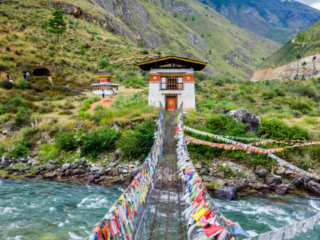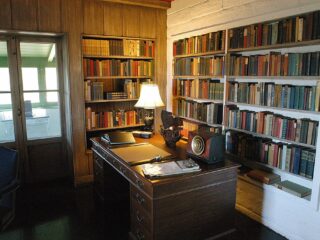by William Caverlee
Today, those on retreat at the Abbey of Gethsemani in Kentucky stay in a shiny new visitors’ facility. However, in the 1970s/80s, when I used to visit there, the retreat house looked like an antiquated college dormitory. Amenities were sparse – it was men only, as well – with showers and bathrooms down the hall. In the cold months, only a few brave pilgrims made the long trek to the backwoods of Kentucky, especially in winter when the rooms were icy and extra blankets got snatched up fast.
Gethsemani is a Trappist monastery near Bardstown, Kentucky, perhaps best known as the home of the writer/monk Thomas Merton (1915-1968). Merton, who was born in France and educated at Cambridge University in England and Columbia University in New York, entered the monastery as a young Catholic convert in 1941. His best-selling autobiography, The Seven Storey Mountain(1948), has never gone out of print, nor have the dozens of other books he wrote during his 27 years as a Trappist.
My first visit to Gethsemani took place one cold week in March. I had flown to Louisville from my home in Louisiana. The little brochure I carried said that I could take a bus from Louisville to Bardstown, then a taxi to the monastery – but first I had to figure out how to get to the bus station. As I stood in the airport, scratching my head, I heard my name called out over the P.A. system. Would I please report to the Delta ticket counter?
When I got there, a man in a work shirt and dungarees introduced himself and asked if I’d like a ride to the monastery. “Absolutely,” I said; and then I asked him if he was a monk. No, he was a layman who lived nearby with his family; he only worked for the monastery; he did odd jobs, ran errands, took the station wagon into Louisville once a week to pick up supplies.
The drive south from Bardstown entered a hilly part of Kentucky called “the knob country.” Highway signs alerted us to “My Old Kentucky Home” and the “Lincoln Homestead,” nearby tourist attractions. The two-lane blacktop road passed a few villages and farms, finally swept along a deep curve and then came upon the monastery, rising suddenly on our left – a collection of white and gray buildings sitting on the top of a hill.
A monk greeted me at the gatehouse and pointed me on my way.
Follow the sidewalk to your right, then up those stairs and through the double doors. Look for Brother Clement. He’s the guestmaster. He’ll show you what to do.
My room on the second floor of the retreat house was the size of a walk-in closet, containing only a bed, lavatory, and desk. A single window looked out onto the visitors’ garden, where I could make out a bent-over, gray-haired monk puttering about with a rake and a wheelbarrow. He was one of the oldest members, I was to learn, gardener and custodian of the retreat house grounds.
When Thomas Merton entered Gethsemani in 1941, the monastery was less than a hundred years old, founded by French monks who had emigrated to Kentucky in 1848. Merton’s early years at Gethsemani were like a journey into the Middle Ages. He wore heavy woolen robes, summer and winter; endured long fasts during Lent; nearly froze in the cavernous, unheated halls where the monks slept on straw-covered cots. Privacy was nonexistent. Monks addressed the abbot as “Lord,” studied Latin, chopped firewood, milked cows, learned sign language (for communicating during long periods of silence), and committed themselves to spending the rest of their lives behind the walls of the abbey.
The monks I met in the 1970s and 80s still wore long, flowing black and white robes, still practiced “ora et labora” – prayer and work – still took vows of poverty, celibacy, and obedience, but their lives were not as harsh as those of Merton’s time. They had private rooms; fasting was not as brutal; the practice of silence not as strict. Their life was no vacation, however, by any stretch of the imagination: a life of near continuous regimentation, of physical labor, prayer, study, restriction, and asceticism.
If I took a short walk down the hall from my room, I arrived at the towering abbey church, its nineteenth-century brick walls painted stark white, its rough-hewn wooden rafters visibly high in the ceiling. Visitors sat in a balcony that looked down onto the monks’ choir stalls. Seven times a day, bells rang, and sixty or so white-cowled monks would troop into church for music, Psalms, and prayer. The monks’ day ended at 7:30 p.m. with Compline and a hymn to Mary, the Salve Regina, after which everyone trooped off to their rooms for the night.
There was no formal schedule for visitors. No classes or meetings. You did more or less what you pleased: took long walks in the abbey woods, observed the liturgical “hours” from the balcony (well, some of them – the first service was at 3 a.m.!), dined silently with the other retreaters in the visitors’ refectory. And dined well. On delicious monks’ bread, monks’ cheese, soup, vegetables, pasta, chicken . . . and fresh coffee, cereal, bacon and eggs, and muffins every morning for breakfast. It is amazing how wonderful food becomes when you eat only three set meals a day. Minus the Coke machines, snack machines. No radio or television either.
During the 1950s and 60s, Merton was the best known Catholic writer in America, possibly in the world. His progressive stance on nonviolence, on civil rights, and on opposition to the Vietnam War kept him in more or less permanent controversy, often in conflict with his own church authorities. He wrote poetry, essays, magazine articles, and books of spirituality. He corresponded with Latin American poets, with Jacques Maritain, Daniel Berrigan, Walker Percy, Flannery O’Connor. His journal Confessions of a Guilty Bystander(1966) reads like a history of the 1960s. His enthusiasms were widespread: Zen Buddhism, jazz, calligraphy, photography, Faulkner, Camus, Bob Dylan, and on and on.
Before entering the monastery in 1941, Merton had lived and traveled widely: France, England, Long Island, Bermuda, Italy, Manhattan, Cuba. . . . Strangely, his life came full circle at the end. He set out on a long trip to Asia in 1968 and died in Bangkok, of accidental electrocution after stepping out of a shower and touching an electric fan. The monks of Gethsemani brought his body back to Kentucky and buried him in the abbey cemetery, with only a simple white cross to mark his grave just like the rest of his brothers.
Today, the name of Thomas Merton still draws readers, scholars, students, and pilgrims to Gethsemani. His books are continually being re-published, with new introductions and annotations. New biographies and critical studies appear regularly. The monks I spoke with at Gethsemani honor his memory and recognize his importance to the abbey. From time to time, though, they confess to a slight impatience with the whole business. It’s as if they want to say:
Our order can trace its roots back to St. Benedict in the sixth century. We’re a heck of a lot bigger than a single writer. Gethsemani is our home – here and now – it’s not just “that place where Thomas Merton lived.”
When my week of retreat came to an end, the monks arranged for the station wagon to take me back to Louisville. As I stood outside the gatehouse with my suitcase, the monk on duty wandered out to say hello. He was a cheerful, ruddy old man. He looked about 60 years-old but was probably close to 80.
“Where did you come from?”
I answered.
“Ah, Louisiana! We’ve got a member here from New Orleans. He entered the same year I did, 1934.”
Then he stretched and yawned and gestured into the bright Kentucky sunlight. I think he was happy to get away from his desk for a moment and feel the fresh air.
“You should have seen this place in the 1950s,” he said. “Hundreds of young men poured in, all wanting to become monks. I don’t know what caused it. The fame of Thomas Merton probably. Also a reaction to the war years, I guess.
Some stayed. Most of them didn’t. I’d see one slipping off by himself to the guesthouse, looking for a telephone. That was the sign – he was calling his parents. A little while later he’d be gone.”
The old monk chuckled to himself, “But it was a fine time. They were all good lads, the ones who stayed and the ones who didn’t. I wouldn’t change a thing . . . Oh, by the way, did you hear the news? . . . There was a problem at a nuclear power plant up in Pennsylvania. I just heard about it from the mailman. Sounds like it was a close call. But it’s over now. Three something . . . Three Mile Island.”
About then, the station wagon arrived, and I said goodbye to my friend and drove away from Gethsemani and Thomas Merton, thinking of the wonderful strangeness of America. Where else do you receive the latest news-flash from a contemplative monk, living in a walled monastery, miles from any television?








